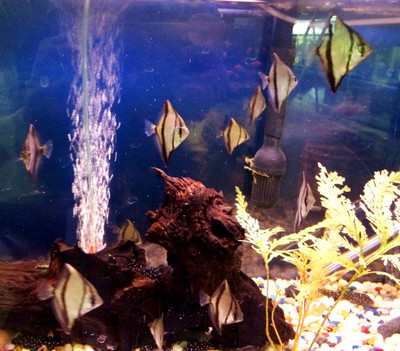Mono Sebae Fish: A Fascinating Aquatic Wonder
Posted by Max Gandara on on 24th May 2023
Exploring the Mystique of the Mono Sebae Fish: A Fascinating Aquatic Wonder
Introduction: In the vast and captivating world of aquarium fish, few species possess the charisma and allure of the Mono Sebae fish (Monodactylus sebae). Also known as the African Moony or African Moony-eyed Fish, the Mono Sebae is a captivating creature that enchants fish enthusiasts with its unique appearance, intriguing behavior, and remarkable adaptability. In this blog post, we will dive deep into the world of the Mono Sebae fish, unraveling its distinct features, care requirements, and its significance in the aquarium hobby.
- Overview and Appearance: Native to the brackish waters of Africa, the Mono Sebae fish boasts an elongated and laterally compressed body. It is characterized by its prominent, crescent-shaped dorsal and anal fins, which lend an exquisite grace to its overall profile. The Mono Sebae's coloration varies, with shades of silver, yellow, and black accentuating its body, while a vivid golden band adorns its caudal fin. Perhaps its most distinctive feature is its striking golden eye, which adds a touch of enigma to this already captivating species.
- Habitat and Tank Requirements: Mono Sebae fish inhabit estuaries, river mouths, and coastal areas, where they experience a blend of freshwater and saltwater. Recreating such conditions in a home aquarium is essential for their well-being. A spacious tank with a capacity of at least 50 gallons is recommended to accommodate a group of Mono Sebae fish, as they thrive in schools. It is crucial to maintain stable water parameters, including a temperature range of 75-82°F (24-28°C), pH level around 7.5-8.5, and a salinity level between 1.005-1.010.
- Feeding and Nutrition: Mono Sebae fish are omnivorous, exhibiting a broad dietary range in their natural habitat. In captivity, they readily accept a varied diet consisting of high-quality flake or pellet food, supplemented with frozen or live foods such as brine shrimp, bloodworms, and small crustaceans. Offering a diverse menu ensures their nutritional needs are met, promoting optimal growth and vibrant coloration.
- Behavior and Compatibility: Known for their lively and active nature, Mono Sebae fish are a joy to observe. They exhibit a hierarchy within their schools, establishing dominance through fin displays and occasional nipping. It is important to provide ample swimming space and suitable tankmates to avoid territorial conflicts. Mono Sebae fish generally coexist well with peaceful, similarly-sized species like mollies, swordtails, and gouramis. Avoid keeping them with overly aggressive or fin-nipping fish.
- Breeding and Reproduction: Breeding Mono Sebae fish in a home aquarium can be challenging, as it requires specific conditions to trigger their reproductive behavior. A separate breeding tank with a slightly higher salinity level (around 1.015) and a temperature of 80-84°F (27-29°C) can help simulate their natural spawning environment. The provision of spawning mops or floating plants encourages the Mono Sebae to release adhesive eggs, which can be carefully collected for hatching. Raising the fry requires specialized care, including frequent water changes and the gradual introduction of brackish water.
- Significance in the Aquarium Hobby: The Mono Sebae fish's popularity in the aquarium hobby can be attributed to its distinctive appearance and engaging behavior. Its elegant swimming motion and unique eye-catching features make it a captivating addition to large, well-maintained community tanks. As with any species, responsible sourcing is crucial to ensure

